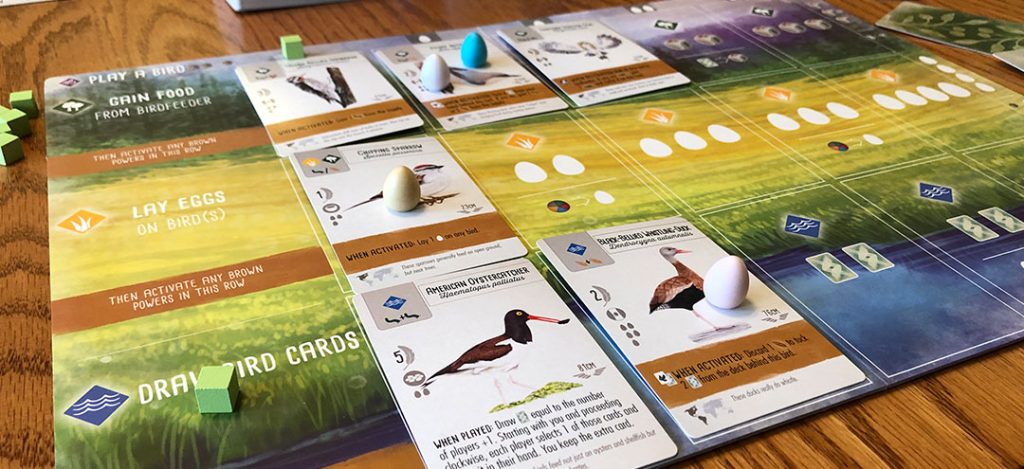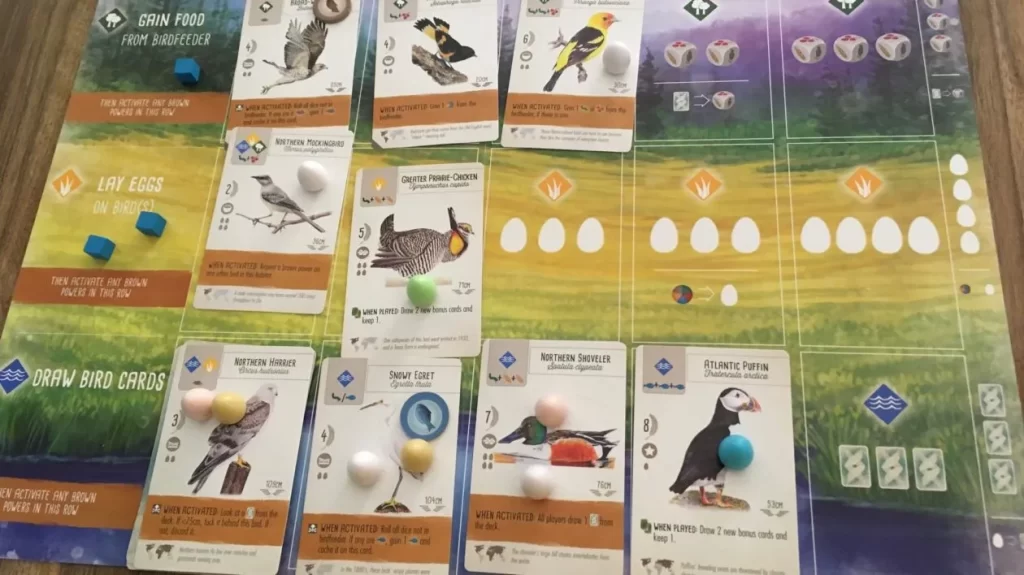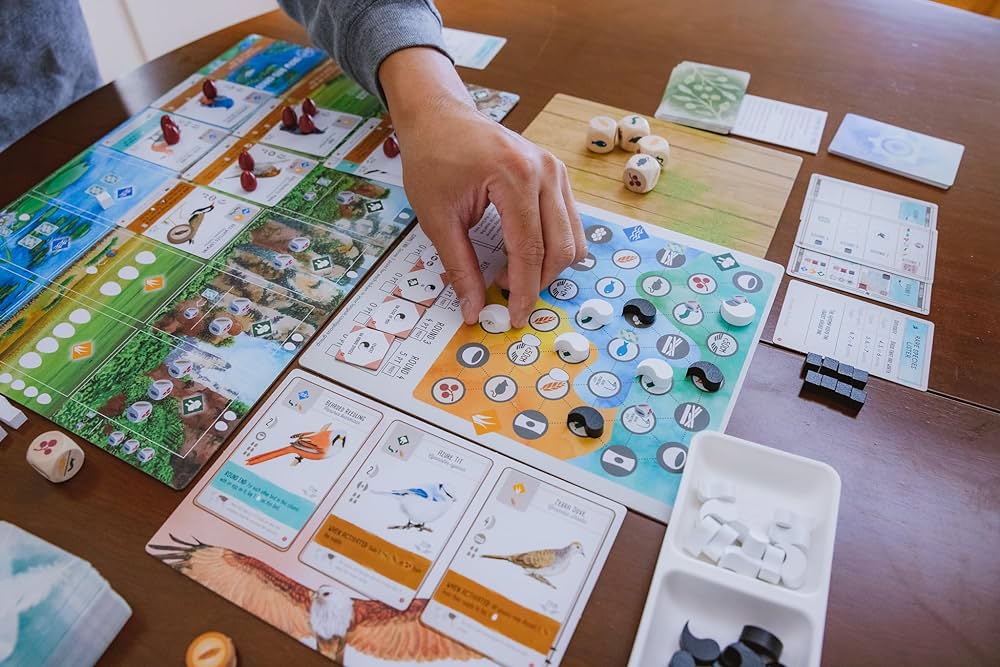Introduction
Wingspan Board Game: Wingspan is a stunningly beautiful and intricately designed board game that has captivated players with its unique theme and engaging mechanics. Created by Elizabeth Hargrave and published by Stone Maier Games, Wingspan board game is a competitive, medium-weight, card-driven, engine-building game where players take on the roles of bird enthusiasts—researchers, bird watchers, ornithologists, and collectors—seeking to discover and attract the best birds to their wildlife preserves.
With a combination of strategic planning, careful resource management, and a bit of luck, players can create a thriving ecosystem and compete to have the most points by the end of the game. This comprehensive guide will walk you through the steps and strategies for playing Wingspan board game, ensuring that you can take flight and enjoy this award-winning game to its fullest.

Setting Up Wingspan Board Game
Wingspan Board Game can before diving into the gameplay, it’s important to set up the game correctly. Wingspan is designed for 1 to 5 players, with a solo mode available for those who prefer to play alone. To set up the game, follow these steps:
Game Board And Player Mats: Place the main game board in the center of the table. Each player receives a player mat, which represents their wildlife preserve, divided into three habitats: forest, grassland, and wetland.
Bird Cards And Bonus Cards: Shuffle the bird cards and create a draw deck. Place three bird cards face up on the bird tray and the remaining deck face down. Shuffle the bonus cards and deal two to each player; players choose one to keep and discard the other.
Food Tokens And Dice: Place the food tokens in the supply area and set the five custom dice in the birdfeeder dice tower. Roll the dice and place them in the birdfeeder.
Eggs And Action Cubes: Place the egg tokens in the supply area. Each player takes eight action cubes in their chosen color.
Goal Tiles And Round Tracker: Shuffle the goal tiles and place one face up on each round space on the round tracker. Place the round tracker on the game board.
Starting Player And Hand Of Bird Cards: Determine the starting player. Each player draws five bird cards and takes one of each type of food token. Players then choose which bird cards to keep (up to five) and discard the same number of food tokens as the number of cards kept.
With the game set up, players are ready to begin their journey into the world of birds.
Understanding The Player Mat And Actions
Wingspan Board Game player mat is divided into three rows (habitats) and five columns (actions). The habitats correspond to different types of birds and actions: forest (gain food), grassland (lay eggs), and wetland (draw bird cards). Each column represents an action that players can take during their turn. Understanding the layout of the player mat is crucial for effective gameplay.
Gameplay Overview
Wingspan Board Game is played over four rounds, with each round consisting of players taking turns to perform one of four possible actions. The number of turns decreases with each round: eight turns in the first round, seven in the second, six in the third, and five in the fourth. The four actions players can take are:
Play A Bird Card: Wingspan Board Game players can play a bird card from their hand by placing it in the appropriate habitat on their player mat. To play a bird, players must pay the required food cost (shown on the bird card) and sometimes an egg cost. Birds provide various benefits, including immediate effects, once-per-round abilities, and end-of-game scoring bonuses.
Gain Food And Activate Forest Birds: Players can gain food tokens by selecting the “gain food” action in the forest habitat. The number of dice rolled and the food obtained depends on the column where the action is taken. Players can also activate birds in the forest habitat from right to left, triggering their abilities.
Lay Eggs And Activate Grassland Birds: Wingspan Board Game players can lay egg tokens on their bird cards by selecting the “lay eggs” action in the grassland habitat. The number of eggs laid depends on the column where the action is taken. Players can also activate birds in the grassland habitat from right to left, triggering their abilities.
Draw Bird Cards And Activate Wetland Birds: Players can draw bird cards from the deck or the face-up bird tray by selecting the “draw bird cards” action in the wetland habitat. The number of cards drawn depends on the column where the action is taken. Players can also activate birds in the wetland habitat from right to left, triggering their abilities.
Building An Efficient Engine

A key aspect of Wingspan Board Game is building an efficient engine that allows you to maximize your actions and points. This involves carefully selecting and playing bird cards that synergize well with each other and the habitats they are placed in. Here are some tips for building an effective engine:
Focus On Synergy: Look for birds that complement each other’s abilities. For example, some birds might help you gain additional food, lay extra eggs, or draw more cards, creating a chain reaction of benefits.
Balance Your Habitats: While it’s tempting to focus on one habitat, balancing your efforts across all three can provide more opportunities and flexibility. Each habitat has its strengths, and neglecting one can limit your options.
Plan For Goals And Bonus Cards: Pay attention to the end-of-round goals and your bonus cards. These can provide significant points if you tailor your strategy to meet their requirements. For example, if a goal rewards having the most birds in the wetland, prioritize playing birds in that habitat.
Manage Resources Wisely: Food and eggs are essential resources in Wingspan Board Game. Ensure you have a steady supply by utilizing your forest and grassland habitats effectively. Sometimes, it’s worth taking an action to gain food or lay eggs even if it doesn’t directly score points.
End Of Round Scoring And Goals
At the end of each round, players score points based on the current goal tile. The goals vary and can include having the most birds in a specific habitat, the most eggs on bird cards, or the most sets of different types of birds. Players place one of their action cubes on the round tracker to indicate their score for that round. This cube is then no longer available for the next round, reducing the number of actions players can take.
End Of Game Scoring
After four rounds of Wingspan Board Game, the game ends, and players tally their final scores. Points are scored in several categories:
Bird Cards: Each bird card has a point value indicated by a feather symbol. Sum the points of all your bird cards.
Bonus Cards: Players reveal their bonus cards and score points based on the criteria specified. For example, a bonus card might reward points for having a certain number of birds with specific characteristics.
End-Of-Round Goals: Add up the points earned from end-of-round goals.
Eggs: Each egg token on bird cards is worth one point.
Food On Cards: Some bird cards allow you to store food tokens on them. Each stored food token is worth one point.
Tucked Cards: Some bird abilities allow you to tuck cards under them. Each tucked card is worth one point.
The player with the most points wins the game. In case of a tie, the player with the most unused food tokens wins.
Advanced Strategies And Tips
To become a master of Wingspan Board Game, consider these advanced strategies and tips:
Adapt To Changing Circumstances: Be flexible and ready to adapt your strategy based on the available bird cards, food, and end-of-round goals. Sometimes, pivoting to a new plan can be more effective than sticking to your original strategy.
Use Bird Abilities Wisely: Timing is crucial when activating bird abilities. Some abilities are more beneficial when used later in the game, while others provide immediate advantages. Plan your actions to make the most of these abilities.
Optimize Your Actions: As the number of actions decreases in later rounds, it’s important to optimize each action. Look for opportunities to gain multiple benefits from a single action, such as triggering multiple bird abilities in a habitat.
Anticipate Your Opponents: Keep an eye on what your opponents are doing. If they are focusing on a particular goal or habitat, consider how you can either complete or avoid direct competition to maximize your own points.
Experiment With Different Strategies: Wingspan Board Game offers a variety of paths to victory. Experiment with different strategies and bird combinations to discover what works best for you. The replayability of the game ensures that no two games are exactly alike.
Solo Mode
Wingspan Board Game also includes a solo mode, where players compete against the Automa, a virtual opponent. The Automa uses a deck of cards to simulate actions and score points. Solo mode follows the same basic rules as multiplayer but with specific adjustments to account for the Automa’s actions. This mode is an excellent way to practice and refine your strategies.

Conclusion
Wingspan Board Game is a delightful and rewarding board game that offers depth, strategy, and endless replayability. Whether you are a bird enthusiast or simply enjoy well-designed games, Wingspan provides a unique and immersive experience. By understanding the rules, optimizing your actions, and building a synergistic engine, you can soar to victory and create a flourishing wildlife preserve. Gather your friends, set up your player mats, and embark on a journey into the avian world with Wingspan. Happy birdwatching!

